|
View as a webpage
|
 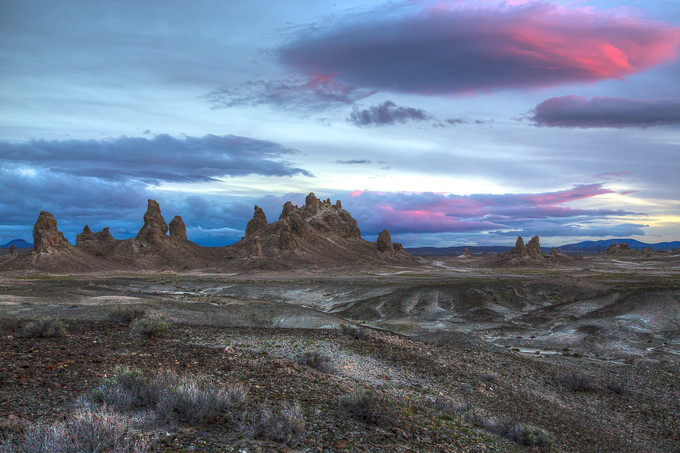 Trona Pinnacles, Ridgecrest Field Office
Photo by Bob Wick, BLM
|
|
ISSUE 924 - October 15, 2020
|
|
|

Cosumnes River Preserve, home to one of the few protected wetland habitats in California
Nestled in the heart of California’s Central Valley, the Cosumnes River Preserve is a critical stop on the Pacific Flyway for migrating and wintering waterfowl. Over 250 species of birds have been sighted on or near the Preserve, including the Swainson hawk, Canada geese and numerous ducks. Sandhill cranes - gray-colored birds with red caps - stand up to 5 feet tall and have a wingspan of 6 to 7 feet. They fly in for winter to fatten up and perform acrobatic mating dances. A must for the bucket list of any bird watcher. (BLM CA Website)
|

Peer inside a coastal tide pool
Check out this 360-degree video from BLM Oregon & Washington that gives us a glimpse into the world of coastal tide pools! When the tide goes out, the ocean leaves behind pools full of anemone, urchin, mussels, crab, barnacles, sea stars and so many more organisms. (BLM CA Facebook)
|
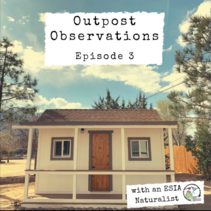
For Earth Science Week, let's learn more about how the Alabama Hills were formed
In this episode of Outpost Observations, naturalist Molly Trauscht explains the natural processes that shaped the unique and magical Alabama Hills. Going back in time 50 million years, Molly explains how chemical weathering and tectonic uplift carved the whimsical shapes we see today.(BLM CA YouTube)
|

ICYMI: The awe-inspiring sights and sounds along the trails of the Santa Rosa and San Jacinto Mountains National Monument reward hikers with timely perspective
A mere quarter-mile from my car in the Indian Canyons parking lot, a gray fox and I surprised each other. I won the staring contest when he beat a retreat into brush at the base of the rocky outcrop I had just rounded. But true honor came from experiencing my first encounter with a fox after 30 years of local hiking. (Palm Springs Life)
|

The Monarch's are starting their migration!
The western monarch butterfly relies on the California landscape for both breeding and overwintering habitat. Unlike the main eastern population of monarch butterflies that migrates to central Mexico to overwinter in huge concentrated clusters, the western population migrates to the coast of California. Here they find moderated temperatures and protection from winter storms by clustering in groves of trees scattered along the coast from Mendocino County to Baja California. (BLM CA Facebook)
|
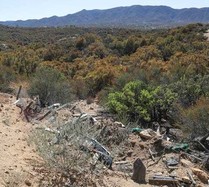
Riverside County tops list of confiscated cannabis as 1.1M plants seized across state
More than a quarter of the illicit cannabis plants seized in California as part of an annual law enforcement operation this year came from Riverside County…About 25% of the raided grow sites and more than 50% of the plants seized came from federal lands. Karen Mouritsen, the California director for the Bureau of Land Management, said such sites can pop up on hard-to-access areas on federal land away from public view. But they can still cause harm to wildlife habitat or endanger the public who are there to recreate, she said. (Desert Sun News)
|
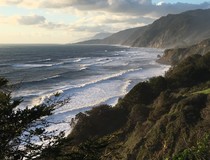
BLM eases fire & target shooting restrictions in NW California
The Bureau of Land Management Redding and Arcata Field Offices have eased some fire restrictions on northern California public lands, now allowing target shooting, campfires within designated campgrounds and recreation sites, and use of barbecues and portable stoves outside of campgrounds. (BLM CA News Release)
|
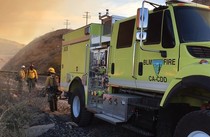
BLM reduced fire restrictions in areas of the California Desert District
Effective immediately, the Bureau of Land Management has reduced fire restrictions in some areas of public lands in Southern CA managed by the California Desert District. Areas previously designated Stage II fire restrictions have been redesignated to Stage I fire restrictions. (BLM CA News Release)
|
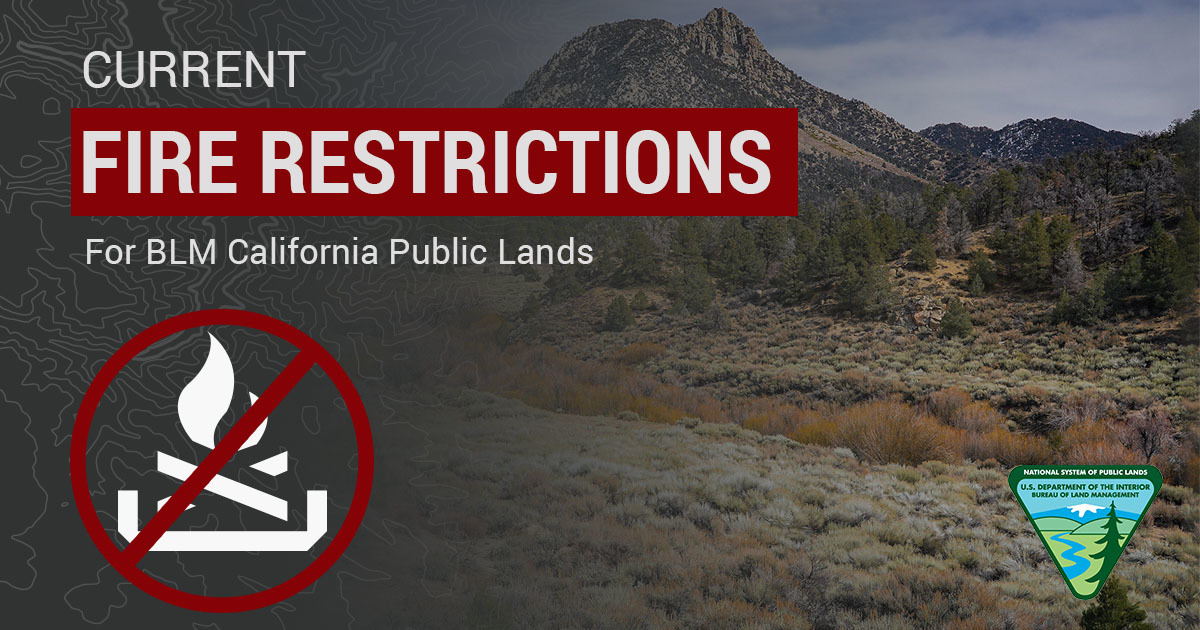 BLM California has issued season fire restrictions due to increased wildland fire danger in the state. Here’s an interactive MAP showing all current fire restrictions. Be sure to bookmark it for future use!
Due to high fire danger, fire restrictions were increased on BLM-managed public lands to prohibit use of all open flames, including campfires, BBQ’s and stoves in Northern and Central California, in addition to the statewide fire prevention order and local district fire and target shooting restrictions. For information about Southern California, see restrictions listed for California Desert District on our Fire Restrictions website: https://go.usa.gov/xGpn8
Seasonal target shooting restrictions are in effect for the Redding Field Office, portions of the California Desert District and all of Central California District. The target shooting restrictions do not apply to individuals with a valid State of California hunting license participating in hunting seasons in areas established by the state.
Berryessa Snow Mountain National Monument and adjacent areas
San Joaquin River Gorge Recreation Area
Case Mountain Recreation Area
Panoche and Tumey Hills vehicle closures extended
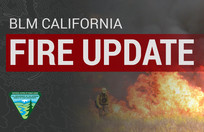
California state fire update
Today Nearly 9,000 firefighters remain on the frontlines of 21 wildfires across the state, 12 of which remain major incidents. Late last night, a new fire erupted near Redlands in San Bernardino County, quickly growing to 100 acres; however, firefighters across the State responded to 26 other new wildfires that were quickly contained.
A Red Flag Warning remains in effect for many parts of Northern California and now a Fire Weather Watch has been issued for the mountains of Ventura and Los Angeles Counties, the Santa Clarita Valley, Inland Empire and Northern San Diego County due to critical fire weather. Gusty winds, low humidity and unseasonably warm temperatures will continue into much of Friday. In preparation of the fire weather, CAL FIRE has increased staffing.
With Red Flag conditions in many parts of the state over the next couple of days, fires in these areas can spread rapidly. Making quick and safe evacuation is critical to protecting your life and your family. To learn ways to be prepared, visit www.ReadyForWildfire.org. (Cal Fire)
|
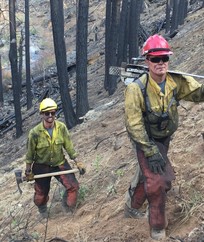
Crews work hard to remove hazards after the Hog Fire in Northern CA
Members of our Eagle Lake Field Office firefighting crews have been hard at work on the steep hillsides along the Bizz Johnson National Recreation Trail, cutting down hazard trees left in the wake of last summer's Hog Fire. Removing trees in danger of falling is only part of the work required for safely reopening a section of trail between the Devil's Corral Trailhead and the Goumaz Trailhead west of Susanville, Calif. The fire burned 9,500 acres in late July and damage was sustained to culverts and a bridge on the trail, plans are being finalized to make repairs. Despite the temporary closure, there are still plenty of opportunities for outings on the trail, including a 14-mile loop option on the Bizz and the adjacent South Side Trail, a scenic single track. (BLM CA Facebook)
|

How to redesign a forest: restoring California’s trees in the age of fire
Last spring, a tree-planting crew hiked into the hills near Paradise, California, to take on a challenge: What’s the best way to replant a forest when it’s very likely that it could burn again? In April, Rempel traveled to California to assist the Bureau of Land Management with replanting an area like this—a pine plantation—that had been obliterated by the Camp Fire. (Fast Company)
|
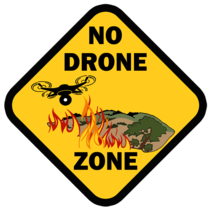 |
|
If you fly, we can't! No drone zone!
Dozens of airspace conflicts are reported yearly within the wildland fire community. Just one incident on a wildfire, however, can adversely affect the safety and efficiency of the overall firefighting effort. (BLM Fire Twitter)
|
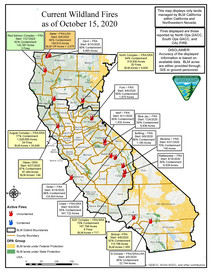
For the latest info on current wildfires in CA, visit these helpful websites:
- Inciweb
- Cal Fire
- National Fire Situational Awareness Tool
Remember to follow your local fire & law enforcement agencies on social media for updates specific to your area and heed all evacuation warning & orders.
While fire activity remains high, please visit our social media pages to get the latest fire map every day:
Facebook or Twitter
|

Trump Administration furthers commitment to One Trillion Trees initiative
An Executive Order directs the Council to develop, coordinate and promote the Federal government’s interactions with the One Trillion Trees Initiative to promote tree growing, conservation, restoration and coordination with key stakeholders. (DOI News Release)
|
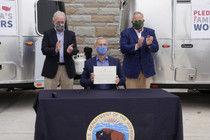
Trump Administration highlights outdoor recreation and RV company signing the Pledge to American Workers
Since the program launched in 2018, more than 450 companies have signed the Pledge to America's Workers, committing to support more than 16.3 million job and training-related opportunities for American workers. (DOI News Release)
|

CORRECT THE RECORD: Bureau of Land Management Deputy Director William Perry Pendley sets record straight regarding Bullock v. BLM opinion
While in Wyoming this past week, Bureau of Land Management Deputy Director William Perry Pendley set the record straight about his role within the agency after a recent decision in Bullock v. BLM by the U.S. District Court for the District of Montana Great Falls Division. (BLM News Release)
|
|

How long do adult Monarch butterflies live during the summer generation?
A. 3-4 days
B. 1 week
C. 10-12 days
D. 2-5 weeks
Keep scrolling to find out!
|
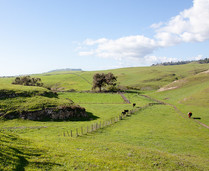
30-day protest period for Cotoni-Coast Dairies proposed plan ends Oct. 26
The Bureau of Land Management Central Coast Field Office has released its Cotoni-Coast Dairies proposed Resource Management Plan Amendment and Environmental Assessment for the California Coastal National Monument that will provide management direction for Cotoni-Coast Dairies public lands in Santa Cruz County. Today’s announcement begins a 30-day protest period and 60-day Governor’s consistency review. (BLM CA News Release)
|

BLM Bakersfield Field Office issues December oil and gas lease sale notice, Kern County - protest period ends Nov. 9
The Bureau of Land Management Bakersfield Field Office is offering seven parcels totaling more than 4,000 acres of Federal minerals for a December oil and gas lease sale. All parcels are in or adjacent to existing oilfields in Kern County. The 30-day protest period ends Nov. 9. (BLM CA News Release)
|
|
Question of the Week Answer
The answer is D. 2-5 weeks! The life cycle of the monarch butterfly is similar to other butterflies, except for their phenomenal migration. An adult female monarch butterfly lays eggs on milkweed plants. The egg hatches as a larva (caterpillar) in approximately four days. The larva feeds on the milkweed plant. The larva matures in 9 to 14 days while going through five instars (or periods between molts), then seeks a sheltered spot and turns into a pupa (chrysalis). After 9 to 15 days an adult butterfly emerges from the pupal case. Monarchs have four to five reproductive generations per year. Adults in the summer generations live two to five weeks, mating when three to eight days old. Adults in the migratory (overwintering) generation may live up to nine months, but do not mate and lay eggs until the following spring. Adults may mate multiple times.
The western population of the Monarch butterfly (west of the Rocky Mountains), travels inland to breeding areas throughout the west from February to March. They migrate to overwintering sites within 2.4 km of the California coast between Mendocino County and Baja, from September to November. They overwinter on eucalyptus trees (Eucalyptus globulus), Monterey pines (Pinus radiata), and/or Monterey cypress (Cupressus macrocarpa) at sites that are cool (but above freezing), sheltered from wind, with a moisture source and exposure to filtered sunlight. The lower slopes of valleys, bays and inlets support the largest numbers. Monarchs are typically found in open grass areas during the breeding season.
Source: USFWS
|
|
|
News.Bytes is a publication of the Bureau of Land Management in California.
Bureau of Land Management
California State Office
2800 Cottage Way, Suite W1623
Sacramento, CA 95825
(916) 978-4600
Send comments to the News.Bytes Team | Subscribe to News.Bytes | Unsubscribe
|
     
|
|
|